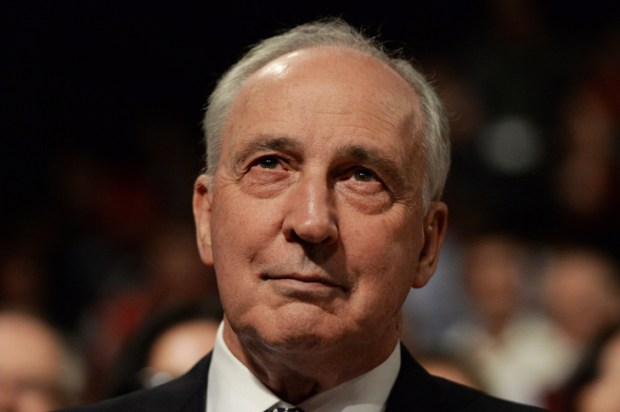At Davos this week, history lived up to its reputation of repeating itself as farce. In the 1980s, the triumvirate of President Reagan, Prime Minister Thatcher and Pope John Paul II brought down communism. In the 2020 remake unfortunately, the Iron Lady has been replaced by a Tyrannical Teen Climate Queen and the Pope is shilling for socialism or at least ‘putting people before profits’.
That leaves President Trump to single-handedly save the world from the scourge not of communism but climatism. Undeniably the former TV game show host lacks the charm of the Hollywood heartthrob — to say nothing about the delivery of his lines — yet Trump has stayed true to President Reagan’s fundamental message of hope.
‘This is not a time for pessimism. This is a time for optimism,’ Trump told the silent crowd at the World Economic Forum, who are no longer jeering now that they are factoring in the very real likelihood of a Trump second term.
‘But to embrace the possibilities of tomorrow, we must reject the perennial prophets of doom and their predictions of the apocalypse,’ Trump continued, decrying them as ‘the heirs of yesterday’s foolish fortune-tellers.’
‘And I have them, and you have them, and we all have them. And they want to see us do badly, but we don’t let that happen,’ he summed up. It’s not quite, ‘Mr Gorbachev, tear down this wall’ but Trump’s optimism is justified. His ally, this time round, is not so much the ‘dismal science’ of economics as mild-mannered researchers in white lab coats who, in a new take on the old alchemist’s dream, are turning carbon dioxide into gold.
Science magazines, awash with good news, are the perfect antidote to doom-mongering mainstream media. A few hours perusing ScienceDaily and you too, like Dr Strangelove, will learn to stop worrying and love CO2.
Last week, for example, in Phys.Org researchers at Michigan, Magill and McMaster universities announced that they have found a way to use sunlight and artificial photosynthesis to turn CO2 into methane, the main component of natural gas. Within five to ten years, they plan to recycle it from smokestack emissions creating clean, green, carbon-neutral gas, a bigger game changer than any government-driven Green New Deal.
Thirty-five per cent of electricity in the US already comes from natural gas which is replacing coal because it’s cheaper, with half the CO2 emissions and no ash or soot. The only limit is a push by some state regulators for even lower carbon emissions but if natural gas is replaced by green methane gas, the existing infrastructure —plants and pipelines —becomes a source of renewable energy.
Meanwhile, researchers at the Massachusetts Institute of Technology have gone one step further, developing a way to remove CO2 from thin air. The process is energy-efficient and the researchers have already set up a company to commercialise it, so it could potentially start to deliver the negative emissions that Greta Thunberg called for at Davos. Naturally, the Green Grinch won’t give up her apocalyptic visions that quickly. She has dismissed ‘technologies that don’t exist at scale yet, and perhaps never will,’ just as she dismisses Trump’s pledge to sign up to an initiative to plant a trillion trees.
In the same vein, thanks to green intransigence, Australia has missed out on most of the domestic benefits of the fracking boom — lower emissions and cheaper energy. Now, continuing growth in US exports of gas will see it overtake Australia as the largest exporter of LNG by 2025, potentially undermining the value and volume of our gas exports.
But the next revolution — making gas from recycled emissions or thin air — could do even greater damage to the Australian economy. While that might seem a long way off, the speed with which the fracking boom is shuttering the US coal industry is a cautionary tale as well as a cause for celebration.
It is not just in fuel supplies that carbon dioxide is coming up trumps, so to speak. The CO2 produced in brewing beer is being used in Sydney to grow algae which can be used for everything from bioplastic and fertilisers to pharmaceuticals, clothing and jet fuel. Scientists in Lyon and Turin have used captured carbon dioxide to purify valuable metal ores. Engineers at Rice University have created a light-powered nanoparticle to shrink the carbon footprint of syngas, which is used to make fuels and chemicals worth USD 46 billion a year. Researchers at Lausanne Polytechnic have patented a process that cuts truck emissions by almost 90 per cent by capturing CO2, converting it into a liquid and turning it back into fuel.
Why so many breakthroughs now? Don’t tell the Pope but it’s thanks to the profit motive. For decades, taxpayers subsidised the capture of carbon dioxide, an endeavour that struggled to become economically viable because the value of sequestration relied on a government mandate and government subsidies. Yet when the problem is tackled by the private sector, researchers and entrepreneurs seek out utility that can be converted into sales and hey presto, we’re reading about carbon capture and utilisation.
The Carbon XPrize, sponsored by Canadian oil sands producers, is a good example. It is offering prize money of USD 20 million for breakthrough technologies that convert CO2 emissions into valuable products. Finalists are turning CO2 into yoga mats, watches, vodka, shoes, toothpaste, fuel and concrete, which creates seven per cent of global emissions. If the new techniques were adopted, they would sequester more than 2 billion tons of emissions a year.
Yet Greta and the Green denialists are impervious to the good news. She claims ‘pretty much nothing has been done’ in the last 12 months. Asked what she would like to happen, she said, ‘that we start listening to the science.’
If only she would, she might get over her fossil fuel phobia, go back to school and leave the rest of us to look forward to flying around the world in planes fuelled by beer while sipping a coal-powered vodka and tonic. Surely, that’s something to celebrate.
Got something to add? Join the discussion and comment below.
Get 10 issues for just $10
Subscribe to The Spectator Australia today for the next 10 magazine issues, plus full online access, for just $10.
You might disagree with half of it, but you’ll enjoy reading all of it. Try your first month for free, then just $2 a week for the remainder of your first year.














Comments
Don't miss out
Join the conversation with other Spectator Australia readers. Subscribe to leave a comment.
SUBSCRIBEAlready a subscriber? Log in